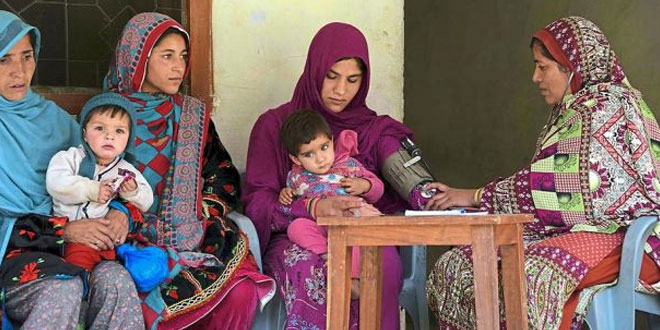
Kashmir women face higher risk of death due to isolation
“We are afraid we could die,” says Asmat Nisa, a mother-of-five set to give birth again.
It is a dangerous prospect for women in the remote mountains of Pakistani-held Kashmir, where doctors are few and help is far.
“There is no hospital here and I have never seen a female doctor,” explains Nisa, who is from the village of Arang Kel in Kashmir’s Neelum Valley.
That her doctor be a woman is important: local customs dictate that male doctors are not permitted to examine women during pregnancy or labour.
This restriction, combined with the isolation and severe weather of the plunging remote valleys, makes giving birth one of the deadliest moments in the lives of its women and newborns.
“The major reason for the deaths of mothers and newborn babies in the remote areas of Neelum Valley is unskilled and untrained midwives assisting the pregnant women during delivery,” says Farhat Shaheen, director of maternal, newborn and child health for Pakistani Kashmir.
Fifty-four babies out of every 1,000 are stillbirths or first day deaths in Kashmir, she says.
In 2014, a report by the charity Save the Children stated Pakistan had the highest rate of first day deaths and stillbirths in the world, at 40.7 per 1,000 births.
In Europe, according to the same report, 5.9 babies for every 1,000 do not survive the first 28 days.
Even neighbouring Afghanistan, torn apart by decades of war, does better than Pakistan, with a rate of 29 first day deaths and stillbirths for every 1,000 births.
“The numbers of the deaths are very high,” Shaheen says.
In the village of Sharda, some 20km from Arang Kel, inhabitants scattered across two mountains face life and death with a single Basic Health Unit (BHU).
The facility has one male doctor rendered useless for pregnancy and childbirth by his gender, and three “Lady Health Visitors”, as they are known locally – women whose job is to create awareness about health and hygiene, but who do not give treatment and not medically trained.
That leaves a lone midwife to help the women of Sharda and the surrounding areas – a population of around 17,000 – through childbirth.
The isolation of the region, which is covered with more than a metre of snow in winter, is a significant factor in medical staff’s reluctance to work there, says Dr Sardar Mahmood Ahmed Khan, director-general of the health service in Pakistani Kashmir.
There is no electricity save a handful of small turbines used to generate hydropower from the streams and rivers sparkling through the valleys – enough to fuel lights, but not much more.
Pregnant women fight to scrape a living on the plunging slopes of the unforgiving mountains: carrying wood, cutting grass, working in the fields, says Riffat Bibi, a Lady Health Visitor at the Sharda BHU, adding that poor nutrition is also a factor ruining maternal health.
“We have to do our hard daily household routine work during our pregnancies,” adds Rubina Bashir, a mother-to-be in Sharda.
The figures Khan cites are stark: of an estimated 4.4 million people in Pakistani Kashmir, he says there are a mere 1,050 doctors.
Some 758 health units – ranging from first aid centres to hospitals – serve the area, with around 3,000 Lady Health Visitors.
Source: AFP

